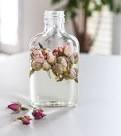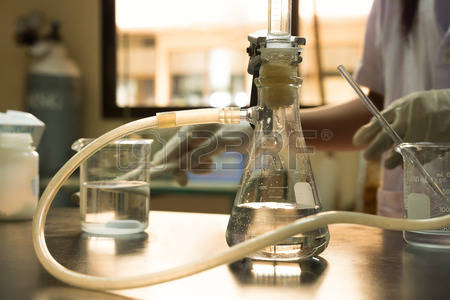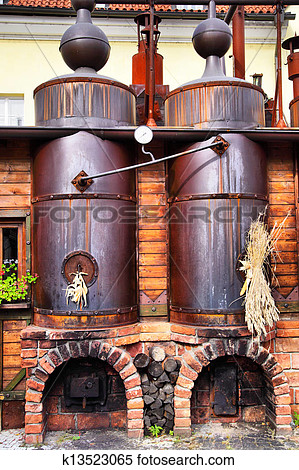Only Sterilized Packaging Components - Hydrosols










Only Sterilized Packaging Components - Hydrosols
When bottling hydrosols for your own use or for resale, it is imperative that you use only clean, ideally sterilized, containers. Bottles are not clean when you pick them up from the warehouse; at the least they are dusty. Whatever method of cleaning you use, wear gloves. Some of the sterilizing liquids, like Ethanol, are hard on your hands. and if you touch a clean area with bare skin it will no longer be "clean".
If you are bottling for home use and will be using up the hydrolate in two or three months, you may find it sufficient to wash the bottles in very hot soapy water and rinse them in a mild vinegar solution or to run them through your dishwasher. For more efficient home cleaning, wash the containers, then dry them in a five-hundred degree oven for twenty minutes.
Bottling for resale requires that you use 95% ethyl alcohol (ethanol), Hydrogen peroxide, or a more efficient sterilization procedure than washing and drying. If you are using plastic caps, do not put them in the oven but do ensure that they are thoroughly dry before bottling begins. Plain water added to a hydrosol shortens its life, and tap water may contain a number of chemicals or bacteria.
Spray bottles are the best choice for small quantities of hydrosol. The sprayer unit can be disassembled quite easily, and ethanol or hydrogen peroxide can be used as sterilization liquid. Boiling sprayer parts may work, depending on the brand of sprayer: you will have to experiment if you wish to try it. However, boiling will not kill all bacteria, and if you are bottling for resale, ethanol is the best choice. Never use anhydrous alcohol, as this has been chemically treated to remove the water content of ethyl.
Food-grade hydrogen peroxide is another viable choice if you cannot obtain ethanol. Both the bottle and the sprayer units can be sterilized with peroxide in the same manner as with alcohol, be sure to use food-grade peroxide and not the topical hydrogen peroxide used for wound cleaning anda bleaching. be careful, peroxide is very strong.
Ethyl alcohol has an advantage over peroxide in that it evaporates very rapidly. Thus, once rinsed, any residue left behind will totally evaporate in a minute or two. I have found it difficult to dry out the drips of hydrogen peroxide fast enough to feel no recontamination occurs under nonlaboratory conditions.
The best method with peroxide is to rinse the items with the peroxide, then dry the parts in a hot oven. Aseptic bottling of foodstuffs often uses this process, although it is automated in those cases.
The protocol we use at Aqua Vita is easy and quite effective. We sanitize just the number of bottles we intend to use immediately. All sprayers are separated into their components and placed in a sealed container of alcohol (sealed because the alcohol evaporates readily).The bottles are then filled and rinsed with alcohol.
The large containers of hydrosols are removed from the cold store only long enough to fill the bottles so that the overall temperature of the bulk quantity dies not change. Some bottling is done in the cold store. The sterile bottles are filled with the hydrosol; the sprayers are removed from the ethyl, quickly dried off, and reassembled; and the lids are put on. We set up a little assembly line, and although it is slightly labor-in tensive, the benefits justify the efforts.
Reference: Hydrosols, The New Aromatherapy: Suzanne Catty
BOTTLES, SALES, AND HOME STORAGE-HYDROSOLS










BOTTLES, SALES, AND HOME STORAGE-HYDROSOLS
The desired parameters for the bottling, sales, and home storage of hydrosols include-
Minimal handling and smelling of product prior to filling - only sterilized packaging components - Proper labelling - No added preservatives - Storage after packaging - Shelf life and marketing
MINIMAL HANDLING AND SMELLING OF PRODUCT PRIOR TO PACKAGING
It's difficult. A big jug of your favourite water or, even worse, a new one youv'e never smelled before arrives at the door. All you want to do is take off the lid and smell it. I used to do it all the time, and I watch every buyer of hydrosol do the same. Scents are addictive. However, smelling directly from the container risks contaminating the whole shipment. it is preferable to decant a small amount into a clean glass to judge flavor, aroma, color, and clarity and to reseal the larger container immediately.
Try using a wine glass, then get your nose in it. Use a teaspoon and taste it straight. Hold it up to a light and see if there is a tint of color or faint milkiness. Look for suspended particulate matter or anything unusual. There are a host of qualities to appreciate, and you will soon learn to read the signs and understand what they mean. After you have examined the pure hydrosol, add a little to a glass of water and taste it again. It is always astounding just how strong pure hydrosols can be and how soft they become when diluted in water.
If you intend to resell your hydrosols, it is worth providing testers. People don't know the waters like they know the oils and will often buy something only if they have a chance to smell or taste it. Testers should have a screw-cap lids so the nose test can be undertaken, and they should be replaced with fresh hydrosol every few weeks or more frequently if heavily used . Although they will last longer if kept cold, I often leave my testers at room temperature so the full aromatic qualities can be appreciated. Cold, their aroma is weaker, and people find it much harder to appreciate their differences.
Reference: Hydrosols; The Next Aromatherapy: Suzanne Catty
Inert Storage Containers






Inert Storage Containers
If the hydrosols are shipped in metal containers, you will want to decant them immediately. Water causes metal to rust. Although aluminum flasks with a phenol-resistant coating are acceptable, they are expensive, and are rarely used for hydrosols except in small retail quantities. Unlined aluminum is unacceptable since, like essential oils, hydrosols may interact with the metal.
Most often hydrosols are shipped in plastic containers. The best plastic containers are made of Nalgene. This is a totally inert plastic, available in a variety of densities, but it is quite expensive. I have never had any problems with leaving the hydrosols in Nalgene in storage. You can also fit taps to these containers, making decanting easier and circumventing the necessity of frequently opening the vessels to pour off small amounts. Rigid plastics are better than softer plastics, as they are less likely to react with the contents.
Many bottle suppliers have a good range of high quality, phenol-resistant plastics that are suitable for shipment and storage of hydrosols. Glass is the ideal medium for transporting hydrosols, and hydrosols seem to do best in cobalt glass.
However at this point cost must be factored in; weight is a consideration in shipping, and glass is breakable, heavy and expensive. Users must make their own decisions.I recommend selling small quantities of hydrosol in glass. Anything over 500millilitres (one-half-liter) should be packaged in a high quality rigid plastic, and I usually advise customers to decant into a glass if feasible.
Generally, if you are storing in a plastic other than Nalgene, you should try to keep your stock rotating. An option is to bottle into plastic to order, minimizing the concerns. Remember, we are not talking about oils here.Hydrosols do not contain the chemical constituents of oils that can melt plastic, Styrofoam, varnish, or paint. No hydrosol is that concentrated, and the percentage of oil that hydrosols contain is too small to worry about. So in most cases, the danger of storing hydrosols in plastic is only marginally greater than storing a mineral water in plastic.
Reference: Hydrosols-The Next Aromatherapy: Suzanne Catty
Filteration for Particulate Matter



 v
v






Filteration for Particulate Matter
It is advisable to fill very large containers of hydrosol upon their arrival. First, this will remove any particulate matter, reducing the substances that can carry bacteria, and second, you are more likely to notice any contamination, molds, and the like that may already be present.
The many methods of filtering waters are described later on, but at the very least a paper filter, such as unbleached coffee filter, should be used. Paper filters are easily sterilized by a very short blast in a microwave oven. Microwave them for only one to two seconds at a time, until you know what your oven's power is like. I prefer not to use microwaves at all, but as a means of sterilizing things they have some use.
Reference: Hydrosols: The next Aromatherapy: Suzanne Catty
Articles - Most Read
- Home
- What are Hydrosols
- What are Hydrosols-2
- The Monographs
- How to Make a Hydrosol
- Table of Common Latin Names and pH Values - F - O
- Distilled or Extracted Specifically For Therapeutic Use - 3
- Kurt Schnaubelt
- What isn't a Hydrosol?
- Table of Common Latin Names and pH Values - P - S
- Wholly Water!
- Blue Babies
- Supply and Demands
- Mature Skin
- Recipes Alpha F
- Hydrosols In The Marketplace
- Chemicals: Friends or Foes?
- Hemorrhoids
- Nelly GrosJean
- Water as Medicine
- The Educated Consumer
- Genitically Modified Plants
- Influences
- Water Quality
Articles-latest
- Daucus carota/Wild Carrot Seed - pH 3.8-4.0
- Cupressus sempervirens/ Cypress-pH3.5-3.7
- Coriandrum sativum/Coriander Herb-and-Seed
- Comptonia peregrinal/Sweet Fern- pH 3.8
- Citrus clementine (fe) Clementine Petitgrain- pH 4.3-4.4
- Citrus aurantium var. amara (flos) /Neroli Orange Blossom-pH3.8-4.5
- Cistus ladaniferus/Rock Rose-pH 2.9-3.1
- Cinnamomum zeylanicum (ec) Cinnamon Bark-pH3.3
- Chamaemelum nobile/Roman Chamomile - pH 3.0-3,3
- Centaurea cyanus/Cornflower/Bachelor's Button-pH 4.7-5.0
- Cedrus atlantical/Cedarwood/Atlas Cedar-pH 4.1- 4.2
- Hydrosols -The PH - Anomalies
- Hydrosols- Establishing Shelf Life and Stability
- Boswellia carterii/FRANKINCENSE
- Asarum canadense/ Wild Ginger/Canadian Ginger
- Artemesia vulgaris / Artemesia
- ARTEMESIA DRACUNCULUS - TARRAGON
- Angelica archangelica / Angelica Root - Hydrosols
- The Key, or More Correctly, the pH - 2 - Hydrosols
- The Key, or More Correctly, the pH-Hydrosols
- The Hard pHacts - Hydrosols
- Calamus Root/Sweet Flag - ACORUS CALAMUS
- Yarrow - Achillea millefolium - Hydrosols
- Balsam Fir - Abies balsamea - Hydrosols

